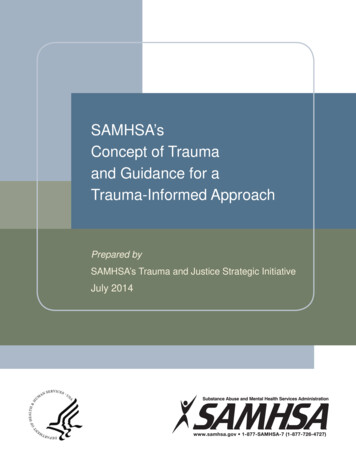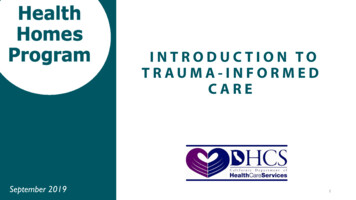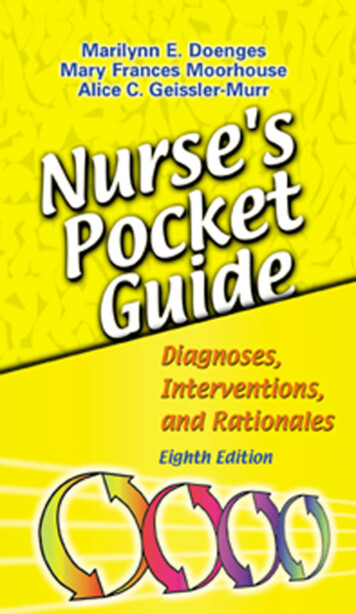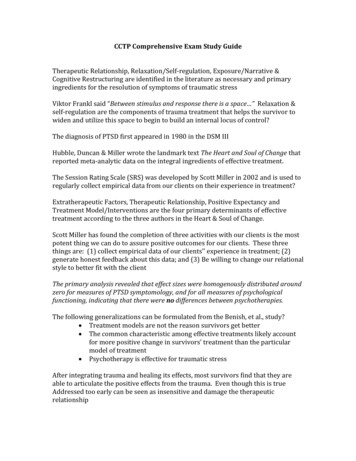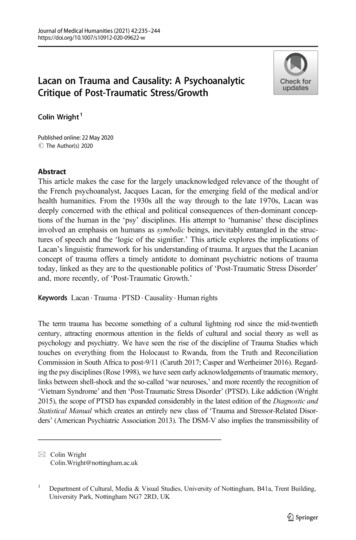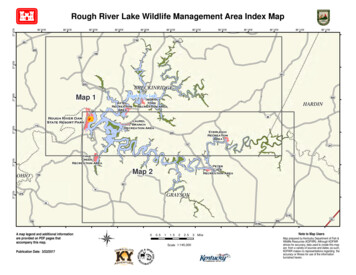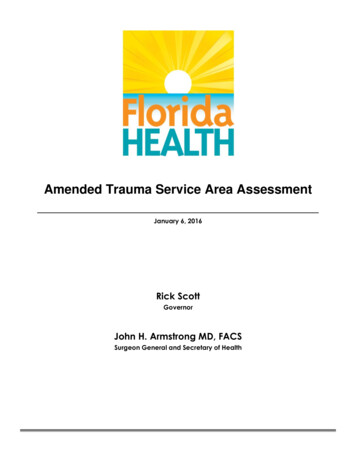
Transcription
Amended Trauma Service Area AssessmentJanuary 6, 2016Rick ScottGovernorJohn H. Armstrong MD, FACSSurgeon General and Secretary of Health
ContentsData Sources . 3Glossary of Terms . 3Review of the Assignment of the 67 Counties to Trauma Service Areas . 5Trauma Center Funding . 6Trauma Service Areas . 7Trauma Service Area 1 . 7Trauma Service Area 2 . 7Trauma Service Area 3 . 9Trauma Service Area 4 . 10Trauma Service Area 5 . 11Trauma Service Area 6 . 12Trauma Service Area 7 . 13Trauma Service Area 8 . 14Trauma Service Area 9 . 15Trauma Service Area 10 . 16Trauma Service Area 11 . 17Trauma Service Area 12 . 18Trauma Service Area 13 . 19Trauma Service Area 14 . 20Trauma Service Area 15 . 21Trauma Service Area 16 . 22Trauma Service Area 17 . 23Trauma Service Area 18 . 24Trauma Service Area 19 . 25Conclusion . 26
FinalData SourcesThe hospital discharge dataset is collected by the Agency for Health CareAdministration (AHCA). It is a comprehensive set of all hospitalizations in the state.Records used for this report are for 2013.The Florida Emergency Medical Services Tracking and Reporting System (EMSTARS)collects incident-level information on millions of EMS incidents every year, forbenchmarking and quality improvement initiatives. EMSTARS currently contains over12 million records. The EMSTARS data used for this report is for 2010-2013.The Florida Trauma Registry collects patient-level data from the state’s verified andprovisional trauma centers, as authorized by section 395.404(1), Florida Statutes.Verified and provisional trauma centers must maintain a comprehensive databaseof those injured patients treated within the hospital. The records used for this reportare for 2013.The data regarding severely injured patients was derived from the AHCA hospitaldischarge database for 2013.US Census Data was used to determine TSA Demographics. Population is based on2013 estimates.Glossary of Terms1) Acute Care Hospital – An acute care hospital is defined by the Agency forHealth Care Administration as a facility type that is equal to a hospital with acutecare bed capacity. Acute care hospitals include trauma centers.2) Statutory Trauma Center Patient Volume – Defined by section 395.402(1), FloridaStatutes. Florida counties with a population of more than 500,000 as of April 1,2015, are Brevard, Broward, Duval, Hillsborough, Lee, Orange, Miami-Dade, PalmBeach, Pinellas, Polk and Volusia.3) Annual Trauma Patient Volume – Trauma patient volume is derived from the statetrauma registry for records submitted by provisional and verified trauma centersfor 2013. No inclusion criteria were applied to the self-reported volumes.4) ICISS: International Classification Injury Severity Score, ICISS is derived using theAgency for Health Care Administration discharge database. Probability of Survival (SRR Survival Risk Ratio): ratio of the number ofpatients with that injury code who have survived to the total number ofpatients diagnosed with that code. Age is included as a predictor variable with the SRR.5) Severely Injured Patient – A patient with injuries as defined in the NationalTrauma Data Standard Patient Inclusion criteria with an ICISS score of .85,excluding a length of stay of less than 24 hours or isolated hip fractures.3
Final6) Severely Injured Patients Discharged from Acute Care Hospitals – The number ofseverely injured patients that were discharged from an acute care hospital(excluding trauma centers) as reflected by the AHCA database of 2013.7) Annual Percent of Patients Discharged from Acute Care Hospitals – The totalnumber of severely injured patients discharged from acute care hospitals(excluding trauma centers) divided by total number of severely injured patients.8) Rotor Wing Aircraft – Rotor Wing Aircraft includes all rotary winged aircraftpermitted by the department. The total number of aircraft per TSA is derivedfrom the Licensure Enforcement and Information Database System (LEIDS).Aircraft such as jets or airplanes are considered fixed wing aircraft and are notincluded in this measure. This is a static look at the LEIDS database for a specifictime period and does not differentiate between active and inactive aircraft.Aircraft represented in this assessment may service multiple TSAs.9) Permitted EMS Ground Vehicles – A vehicle that is permitted by the departmentto perform Basic Life Support or Advanced Life Support and transport patients toa receiving facility. The total number of permitted EMS ground vehicles per TSA isderived from a static look from the Licensing and Enforcement InformationDatabase System (LEIDS) database and does not differentiate between activeand inactive vehicles. EMS ground vehicles represented in this assessment mayservice multiple TSAs.10) EMS Ground Vehicle to Population Ratio – The total number of permitted groundvehicles, regardless of transport or non-transport status, to a population of 10,000residents.(Total number EMS Ground Vehicles/Population)*10,00011) EMS Ground Vehicle to 100 Square Miles Ratio – The total number of permittedground vehicles, regardless of transport or non-transport status, to 100 squaremiles. (Total number EMS ground Vehicles/Total Land Area)*10012) Median Transport Time – The median EMS transport time is derived from theEmergency Medical Services Tracking and Reporting System (EMSTARS). Allpatients transported to a verified trauma center are included regardless of illnessor injury. EMS transport time is the difference between the time the EMS unitarrived at the hospital and the time the unit left the scene. Transport timeincludes all EMSTARS records submitted from 2010 to 2013 with a Type of ServiceRequested equal to 911-scene or intercept. Records that had a mediantransport time of greater than 2 hours were excluded.4
FinalReview of the Assignment of the 67 Counties to Trauma Service AreasSince 1990, Florida's sixty-seven counties have been assigned to nineteen traumaservice areas (TSAs) pursuant to section 395.402, Florida Statutes. As required bylegislative amendments to the trauma statutes in 2004, the assignment of counties toTSAs is to be reviewed annually. The first such review occurred on February 1, 2005,when the Department released A Comprehensive Assessment of the Florida TraumaSystem which was conducted by the University of South Florida. The 2005 assessmentconsidered transforming Florida's TSAs so that the boundaries of the TSAs would beidentical to the boundaries of the Regional Domestic Security Task Forces (RDSTFs), thusrealigning counties and reducing the number of TSAs to seven. While the assessmentdetermined it may be possible to transform the TSAs into areas that coincide with theRDSTFs, it noted that regional trauma agencies would need to be developed in each ofthe larger geographical areas in order to make the transformation feasible.As part of this Assessment, the Department again evaluated the possibility of alteringthe current county assignments to establish TSAs that are identical to the RDSTFs. At thistime, Florida has just one regional trauma agency and three local trauma agencies.None of the regional or local trauma agencies have boundaries that are identical tothe RDSTFs. Neither the one regional trauma system plan in existence nor the statetrauma system plan recommend realignment of counties into the RDSTFs for allocationpurposes. While the RDSTFs present opportunities for planning and performanceimprovement, the RDSTFs are too large a geographic area to ensure the evendistribution of trauma centers throughout Florida. Without the existence of regionaltrauma agencies in each of the trauma regions, the allocation of trauma centersthroughout the state should continue to be guided by the more geographicallycompact TSAs.Also as part of this Assessment, the Department evaluated the current countyassignments to TSAs. The existing TSAs have been used to guide trauma centerdevelopment in Florida since 1990 and are familiar to all stakeholders of the traumasystem. On review, the Department has determined that none of the current countyassignments require realignment at this time. The most appropriate alignment ofcounties is described in section 395.402(4)(a), Florida Statutes.5
FinalTrauma Center FundingThe Florida Legislature provides funding for existing trauma centers through portions ofthe revenue from red light camera fines and other traffic-related fines. The fundingprovided to existing trauma centers has increased significantly in past years as a resultof the installation of red light cameras throughout Florida.Funds distributed to trauma centers in calendar year 2012 represented the highest levelto date at 12,683,771.76. However in 2013, red light camera funding begandecreasing due to a reduction in funds generated. Between fiscal years 2012-2013 and2013-2014, this reduction represented about 1.4 million, or 12%.The current funding methodology is prescribed by section 395.4036, Florida Statutes,and uses trauma patient volumes to disburse funds.6
FinalTrauma Service AreasTrauma Service Area 1TSA Trauma System Information# Verified Level I Trauma Centers0# Verified Level II Trauma Centers2# Acute Care Hospitals11Statutory Patient Volume1,000Annual Trauma PatientVolume Reported by TraumaCenters2,241# Severely Injured Patients407Annual # of Severely Injured PatientsDischarged from Acute Care Hospitals86Annual % of Severely InjuredPatients Discharged from AcuteCare Hospitals21.13%TSA Emergency Medical ServicesTSA Demographics# Rotor Wing Aircraft3# Permitted EMS GroundVehicles91Population720,531EMS Ground Vehicle toPopulation Ratio1.26:10,000Population Densitypersons/sq. mile198.22EMS Ground Vehicleto100 Square Miles Ratio2.50:10010 Year PopulationGrowth Rate9.5%Median Age38.2Median Transport Time00:14:00% Persons 65 & Over15.2%% Persons Under 1821.7%Total Land Area3,635 sq milesCity/County Govts16hh:mm:ss7
FinalTrauma Service Area 2TSA Trauma System Information# Verified Level I Trauma Centers0# Verified Level II Trauma Centers1# Acute Care Hospitals5Statutory Patient Volume500Annual Trauma PatientVolume Reported by TraumaCenters790# Severely Injured Patients133Annual # of Severely Injured Patients21Discharged From Acute Care HospitalsAnnual % of Severely InjuredPatients Discharged From AcuteCare Hospitals15.79%TSA DemographicsTSA Emergency Medical Services# Rotor Wing Aircraft0Population235,157# Permitted EMS TransportVehicles43Population Densitypersons/sq. mile98.64EMS Ground Vehicle toPopulation Ratio1.83:10,00010 Year PopulationGrowth Rate11.9%EMS Ground Vehicle to100 Square Miles Ratio1.80:100Median Age41.6% Persons 65 & Over16.3%Median Transport Time00:39:00% Persons Under 1820.9%Total Land Area2,384 sq milesCity/County Govts16hh:mm:ss8
FinalTrauma Service Area 3TSA Trauma System Information# Verified Level I Trauma Centers0# Verified Level II Trauma Centers1# Acute Care Hospitals9Statutory Patient Volume500Annual Trauma PatientVolume Reported by TraumaCenters1,134# Severely Injured Patients244Annual # of Severely Injured Patients26Discharged From Acute Care HospitalsAnnual % of Severely InjuredPatients Discharged From AcuteCare Hospitals10.66%TSA DemographicsTSA Emergency Medical Services# Rotor Wing Aircraft3# Permitted EMS TransportVehicles90EMS Ground Vehicle toPopulation Ratio1.81:10,000EMS Ground Vehicle to100 Square Miles Ratio1.29:100Median Transport Time00:16:00hh:mm:ss9Population498,391Population Densitypersons/sq. mile71.3810 Year PopulationGrowth Rate11.4%Median Age40.9% Persons 65 & Over13.2%% Persons Under 1819.6%Total Land Area6,982 sq milesCity/County Govts28
FinalTrauma Service Area 4TSA Trauma System Information# Verified Level I Trauma Centers1# Verified Level II Trauma Centers0# Acute Care Hospitals10Statutory Patient Volume1,000Annual Trauma PatientVolume Reported by TraumaCenters2,524# Severely Injured Patients466Annual # of Severely Injured Patients67Discharged From Acute Care HospitalsAnnual % of Severely InjuredPatients Discharged From AcuteCare HospitalsTSA DemographicsTSA Emergency Medical ServicesPopulation575,088Population Densitypersons/sq. mile83.8710.5%# of Rotor Wing Aircraft610 Year PopulationGrowth Rate# of Permitted EMS TransportVehicles83Median Age40.8% Persons 65 & Over15.7%EMS Ground Vehicle toPopulation Ratio1.44:10,000% Persons Under 1819.6%Total Land Area6,856 sq milesEMS Ground Vehicle to100 Square Miles Ratio1.21:100City/County Govts32Median Transport Time00:38:00hh:mm:ss1014.38%
FinalTrauma Service Area 5TSA Trauma System Information# Verified Level I Trauma Centers1# Verified Level II Trauma Centers0# Acute Care Hospitals13Statutory Patient Volume1,000Annual Trauma PatientVolume Reported by TraumaCenters2,506# Severely Injured Patients811Annual # of Severely Injured Patients304Discharged From Acute Care HospitalsAnnual % of Severely InjuredPatients Discharged From AcuteCare Hospitals37.48%TSA DemographicsTSA Emergency Medical ServicesPopulation1,394,624229Population Densitypersons/sq. mile435.68EMS Ground Vehicle toPopulation Ratio1.64:10,00010 Year PopulationGrowth Rate16.7%Median Age39.0EMS Ground Vehicle to100 Square Miles Ratio7.15:100% Persons 65 & Over13.7%% Persons Under 1823.0%Median Transport Time00:09:00Total Land Area3,201 sq milesCity/County Govts15# Rotor Wing Aircraft3# Permitted EMS TransportVehicleshh:mm:ss11
FinalTrauma Service Area 6TSA Trauma System Information# Verified Level I Trauma Centers0# Verified Level II Trauma Centers1# Acute Care Hospitals8Statutory Patient Volume500Annual Trauma PatientVolume Reported by TraumaCenters1,821# Severely Injured Patients420Annual # of Severely Injured Patients136Discharged From Acute Care HospitalsAnnual % of Severely InjuredPatients Discharged From AcuteCare Hospitals32.38%TSA DemographicsTSA Emergency Medical ServicesPopulation651,074246.71# Rotor Wing Aircraft3# Permitted EMS TransportVehicles94Population Densitypersons/sq. mile19.0%EMS Ground Vehicle toPopulation Ratio1.44:10,00010 Year PopulationGrowth RateMedian Age48.8EMS Ground Vehicle to100 Square Miles Ratio3.56:100% Persons 65 & Over28.9%% Persons Under 1818.1%Median Transport Time00:24:00Total Land Area2,639 sq milesCity/County Govts10hh:mm:ss12
FinalTrauma Service Area 7TSA Trauma System Information# Verified Level I Trauma Centers0# Verified Level II Trauma Centers1# Acute Care Hospitals8Statutory Patient Volume1,000Annual Trauma PatientVolume Reported by TraumaCenters1,968# Severely Injured Patients376Annual # of Severely Injured Patients109Discharged From Acute Care HospitalsAnnual % of Severely InjuredPatients Discharged From AcuteCare Hospitals28.99%TSA DemographicsTSA Emergency Medical Services# Rotor Wing Aircraft4# Permitted EMS TransportVehicles64EMS Ground Vehicle toPopulation Ratio1.07:10,000EMS Ground Vehicle to100 Square Miles Ratio4.04:100Median Transport Time00:12:17hh:mm:ss13Population600,756Population Densitypersons/sq. mile378.7910 Year PopulationGrowth Rate13.7%Median Age47.95% Persons 65 & Over23.6%% Persons Under 1818.3%Total Land Area1,586 sq milesCity/County Govts16
FinalTrauma Service Area 8TSA Trauma System Information# Verified Level I Trauma Centers1# Verified Level II Trauma Centers0# Acute Care Hospitals21Statutory Patient Volume1,000Annual Trauma PatientVolume Reported by TraumaCenters4,422# Severely Injured Patients1,088Annual # of Severely Injured Patients437Discharged From Acute Care HospitalsAnnual % of Severely InjuredPatients Discharged From AcuteCare HospitalsTSA DemographicsTSA Emergency Medical ServicesPopulation2,374,902Population Densitypersons/sq. mile590.0427.5%# Rotor Wing Aircraft410 Year PopulationGrowth Rate# Permitted EMS TransportVehicles332Median Age39.0% Persons 65 & Over15.2%EMS Ground Vehicle toPopulation Ratio1.40:10,000% Persons Under 1822.0%Total Land Area4,025 sq milesEMS Ground Vehicle to100 Square Miles Ratio8.25:100City/County Govts40Median Transport Time00:14:00hh:mm:ss1440.17%
FinalTrauma Service Area 9TSA Trauma System Information# Verified Level I Trauma Centers0# Verified Level II Trauma Centers2# Acute Care Hospitals19Statutory Patient Volume1,500Annual Trauma PatientVolume Reported by TraumaCenters4,004# Severely Injured Patients996Annual # of Severely Injured Patients362Discharged From Acute Care HospitalsAnnual % of Severely InjuredPatients Discharged From AcuteCare Hospitals36.35%TSA DemographicsTSA Emergency Medical Services# Rotor Wing Aircraft0# Permitted EMS TransportVehicles129EMS Ground Vehicle toPopulation Ratio0.92:10,000EMS Ground Vehicle to100 Square Miles Ratio12.63:100Median Transport n Densitypersons/sq. mile1,375.6610 Year PopulationGrowth Rate7.3%Median Age45.8% Persons 65 & Over22.4%% Persons Under 1818.4%Total Land Area1,021 sq milesCity/County Govts23
FinalTrauma Service Area 10TSA Trauma System Information# Verified Level I Trauma Centers1# Verified Level II Trauma Centers1# Acute Care Hospitals12Statutory Patient Volume2,000Annual Trauma PatientVolume Reported by TraumaCenters4,477# Severely Injured Patients943Annual # of Severely Injured Patients162Discharged From Acute Care HospitalsAnnual % of Severely InjuredPatients Discharged From AcuteCare HospitalsTSA DemographicsTSA Emergency Medical ServicesPopulation1,291,578Population Densitypersons/sq. mile1,266.2520.5%# Rotor Wing Aircraft210 Year PopulationGrowth Rate# Permitted EMS TransportVehicles202Median Age36.6% Persons 65 & Over12.8%EMS Ground Vehicle toPopulation Ratio1.56:10,000% Persons Under 1823.4%Total Land Area1,020 sq milesEMS Ground Vehicle to100 Square Miles Ratio19.80:100City/County Govts4Median Transport Time00:14:00hh:mm:ss1617.18%
FinalTrauma Service Area 11TSA Trauma System Information# Verified Level I Trauma Centers0# Verified Level II Trauma Centers1# Acute Care Hospitals10Statutory Patient Volume1,000Annual Trauma PatientVolume Reported by TraumaCenters1,507# Severely Injured Patients415Annual # of Severely Injured Patients78Discharged From Acute Care HospitalsAnnual % of Severely InjuredPatients Discharged From AcuteCare Hospitals18.80%TSA DemographicsTSA Emergency Medical ServicesPopulation748,144Population Densitypersons/sq. mile216.73# Rotor Wing Aircraft410 Year PopulationGrowth Rate19.5%# Permitted EMS TransportVehicles84Median Age40.4EMS Ground Vehicle toPopulation Ratio1.12:10,000% Persons 65 & Over20.9%% Persons Under 1822.5%Total Land Area3,452 sq milesEMS Ground Vehicle to100 Square Miles Ratio2.43:100City/County Govts19Median Transport Time00:20:00hh:mm:ss17
FinalTrauma Service Area 12TSA Trauma System Information# Verified Level I Trauma Centers0# Verified Level II Trauma Centers1# Acute Care Hospitals9Statutory Patient Volume1,000Annual Trauma PatientVolume Reported by TraumaCenters1,823# Severely Injured Patients388Annual # of Severely Injured Patients150Discharged From Acute Care HospitalsAnnual % of Severely InjuredPatients Discharged From AcuteCare Hospitals38.66%TSA DemographicsTSA Emergency Medical ServicesPopulation692,817Population Densitypersons/sq. mile456.10# Rotor Wing Aircraft110 Year PopulationGrowth Rate11.2%# Permitted EMS TransportVehicles72Median Age48.7EMS Ground Vehicle toPopulation Ratio1.04:10,000% Persons 65 & Over23.6%% Persons Under 1818.7%EMS Ground Vehicle to100 Square Miles Ratio4.74:100Total Land Area1,519 sq milesCity/County Govts15Median Transport Time00:11:00hh:mm:ss18
FinalTrauma Service Area 13TSA Trauma System Information# Verified Level I Trauma Centers0# Verified Level II Trauma Centers1# Acute Care Hospitals8Statutory Patient Volume500Annual Trauma PatientVolume Reported by TraumaCenters1,097# Severely Injured Patients503Annual # of Severely Injured Patients284Discharged From Acute Care HospitalsAnnual % of Severely InjuredPatients Discharged From AcuteCare Hospitals56.46%TSA DemographicsTSA Emergency Medical ServicesPopulation767,05292Population Densitypersons/sq. mile396.201.20:10,00010 Year PopulationGrowth Rate15.4%Median Age46.8% Persons 65 & Over29.0%% Persons Under 1817.6%Total Land Area1,936 sq milesCity/County Govts12# Rotor Wing Aircraft1# Permitted EMS TransportVehiclesEMS Ground Vehicle toPopulation RatioEMS Ground Vehicle to100 Square Miles Ratio4.75:100Median Transport Time00:10:00hh:mm:ss19
FinalTrauma Service Area 14TSA Trauma System Information# Verified Level I Trauma Centers0# Verified Level II Trauma Centers1# Acute Care Hospitals6Statutory Patient Volume500Annual Trauma PatientVolume Reported by TraumaCenters1,404# Severely Injured Patients298Annual # of Severely Injured Patients88Discharged From Acute Care HospitalsAnnual % of Severely InjuredPatients Discharged From AcuteCare HospitalsTSA DemographicsTSA Emergency Medical Services# Rotor Wing Aircraft2# Permitted EMS TransportVehicles74EMS Ground Vehicle toPopulation Ratio1.55:10,000EMS Ground Vehicle to100 Square Miles Ratio3.93:100Median Transport Time00:09:00hh:mm:ss20Population477,425Population Densitypersons/sq. mile253.4110 Year PopulationGrowth Rate24.2%Median Age43.9% Persons 65 & Over23.8%% Persons Under 1820.1%Total Land Area1,884 sq milesCity/County Govts729.53%
FinalTrauma Service Area 15TSA Trauma System Information# Verified Level I Trauma Centers0# Verified Level II Trauma Centers1# Acute Care Hospitals9Statutory Patient Volume1,000Annual Trauma PatientVolume Reported by TraumaCenters1,867# Severely Injured Patients585Annual # of Severely Injured Patients198Discharged From Acute Care HospitalsAnnual % of Severely InjuredPatients Discharged From AcuteCare HospitalsTSA DemographicsTSA Emergency Medical Services# Rotor Wing Aircraft2# Permitted EMS TransportVehicles125EMS Ground Vehicle toPopulation Ratio1.43:10,000EMS Ground Vehicle to100 Square Miles Ratio3.65:100Median Transport Time00:26:00hh:mm:ss21Population876,667Population Densitypersons/sq. mile256.010 Year PopulationGrowth Rate27.1%Median Age46.2% Persons 65 & Over27.2%% Persons Under 1818.2%Total Land Area3,424 sq milesCity/County Govts1333.85%
FinalTrauma Service Area 16TSA Trauma System Information# Verified Level I Trauma Centers2# Verified Level II Trauma Centers0# Acute Care Hospitals14Statutory Patient Volume2,000Annual Trauma PatientVolume Reported by TraumaCenters3,257# Severely Injured Patients779Annual # of Severely Injured Patients225Discharged From Acute Care HospitalsAnnual % of Severely InjuredPatients Discharged From AcuteCare HospitalsTSA DemographicsTSA Emergency Medical ServicesPopulation1,372,171Population Densitypersons/sq. mile696.53# Rotor Wing Aircraft210 Year PopulationGrowth Rate13.5%# Permitted EMS TransportVehicles214Median Age44.1EMS Ground Vehicle toPopulation Ratio1.56:10,000% Persons 65 & Over22.5%% Persons Under 1819.7%Total Land Area1,970 sq milesCity/County Govts13EMS Ground Vehicle to100 Square Miles Ratio10.86:100Median Transport Time00:08:23hh:mm:ss2228.88%
FinalTrauma Service Area 17TSA Trauma System Information# Verified Level I Trauma Centers0# Verified Level II Trauma Centers0# Acute Care Hospitals4Statutory Patient Volume0Annual Trauma PatientVolume Reported by TraumaCenters0# Severely Injured Patients150Annual # of Severely Injured Patients150Discharged From Acute Care HospitalsAnnual % of Severely InjuredPatients Discharged From AcuteCare HospitalsTSA DemographicsTSA Emergency Medical Services# Rotor Wing Aircraft1# Permitted EMS TransportVehicles37EMS Ground Vehicle toPopulation Ratio1.09:10,000EMS Ground Vehicle to100 Square Miles Ratio1.85:100Median Transport Time00:15:41hh:mm:ss23Population339,642Population Densitypersons/sq. mile169.9910 Year PopulationGrowth Rate19.2%Median Age48.6% Persons 65 & Over28.9%% Persons Under 1818.5%Total Land Area1,998 sq milesCity/County Govts3100%
FinalTrauma Service Area 18TSA Trauma System Information# Verified Level I Trauma Centers2# Verified Level II Trauma Centers1# Acute Care Hospitals16Statutory Patient Volume3,000Annual Trauma PatientVolume Reported by TraumaCenters5,481# Severely Injured Patients909Annual # of Severely Injured Patients219Discharged From Acute Care HospitalsAnnual % of Severely InjuredPatients Discharged From AcuteCare Hospitals24.09%TSA Emergency Medical ServicesTSA Demographics# Rotor Wing Aircraft4# Permitted EMS TransportVehicles273EMS Ground Vehicle toPopulation Ratio1.48:10,000EMS Ground Vehicle to100 Square Miles Ratio22.56:100Median Transport n Densitypersons/sq. mile1519.7110 Year PopulationGrowth Rate7.0%Median Age39.9% Persons 65 & Over15.0%% Persons Under 1821.8%Total Land Area1,210 sq milesCity/County Govts25
FinalTrauma Service Area19TSA Trauma System Information# Verified Level I Trauma Centers1# Verified Level II Trauma Centers1# Acute Care Hospitals29Statutory Patient Volume2,000Annual Trauma PatientVolume Reported by TraumaCenters6,903# Severely Injured Patients1,488Annual # of Severely Injured Patients466Discharged From Acute Care HospitalsAnnual % of Severely InjuredPatients Discharged From AcuteCare HospitalsTSA DemographicsTSA Emergency Medical Services# Rotor Wing Aircraft9#Permitted EMS TransportVehicles483EMS Ground Vehicle toPopulation Ratio1.79:10,000EMS Ground Vehicle to100 Square Miles Ratio16.77:100Median Transport n Densitypersons/sq. mile934.9310 Year PopulationGrowth Rate10.8%Median Age43.15% Persons 65 & Over15.1%% Persons Under 1820.7%Total Land Area2,881 sq milesCity/County Govts2432.32%
FinalConclusionBased upon available data and the reliability of the data, the Department hasdetermined that the following criteria should be used to evaluate the number and levelof trauma centers needed to serve the population in a defined trauma service area:1.Population2.Median Transport Times3.Community Support4.Number of Severely Injured Patients Not Treated In Trauma Centers5.The Existence of a Level I Trauma Center6.Number of Severely Injured Patients26
the revenue from red light camera fines and other traffic-related fines. The funding provided to existing trauma centers has increased significantly in past years as a result of the installation of red light cameras throughout Florida. Funds distributed to trauma centers in calendar year 2012

